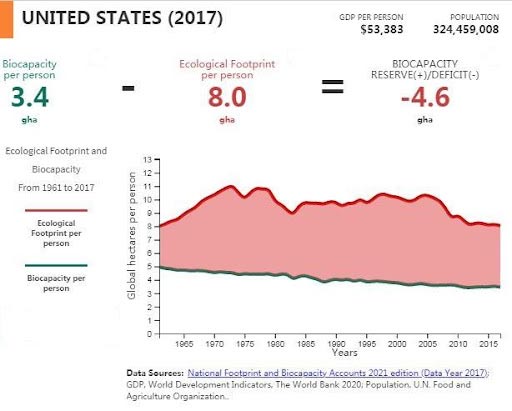Developed land includes much more than urban residential areas alone. It also includes other built-up land uses, including transportation, light and heavy industrial, commercial retail and office, institutional, and even urban park space.
In 2017, American consumers/residents on average used or “consumed” 0.356 acre of developed land per capita, or a little over one-third of an acre per person. This 0.356-acre/resident metric does not include relatively unpopulated rural lands – farmlands (cropland, pasture, and rangeland), forests, reservoirs, mines – that furnish crucial raw materials and products used by every consumer/resident, namely food, fiber, fuels, water, energy, metals, and minerals.
Nor does it include the forestlands needed to absorb each American resident’s or consumer’s carbon dioxide (CO2) emissions from fossil fuel combustion to produce electricity and propel our vehicles. All of these ecologically productive lands not covered with pavement and buildings, but used indirectly by each and every U.S. resident (and all human consumers), contribute to each average American’s per capita ecological footprint. This entails a much larger amount of land, 56 times greater as much in fact, or approximately 20 global acres (8.0 global hectares) per person, according to the Global Footprint Network.
In 2017, the United States had a per capita ecological deficit of 4.6 global hectares (one hectare equals 2.47 acres). According to the Global Footprint Network, an ecological deficit occurs when the Ecological Footprint of a given population exceeds the “biocapacity” (ecologically productive lands capable of large-scale photosynthesis) of the area available to that population. A national ecological deficit means that the United States is importing biocapacity through trade, “liquidating” national ecological assets or emitting the CO2 waste product or “residual” into the atmosphere. (In contrast, an ecological reserve exists when the biocapacity of a region or country exceeds its population’s Ecological Footprint.)

Source: Global Footprint Network